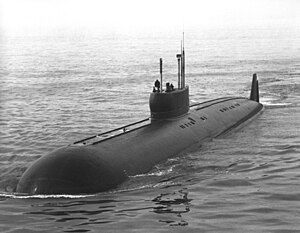Soviet submarine K-222

| |
| History | |
|---|---|
| Name | K-162 |
| Yard number | 501[1] |
| Laid down | 28 December 1963[1] |
| Launched | 21 December 1968[1] |
| Commissioned | 31 December 1969[1] |
| Decommissioned | 1984 in reserve, deleted from from Navy list at 1989, Russian Navy flag was lowered 1999. |
| Fate | scrapped at 2010 at "Zvezdochka" plant (c. Severodvinsk), 3-section reactor block stand near berth №27. |
| General characteristics | |
| Type | Submarine |
| Displacement | list error: <br /> list (help) 5,197 long tons (5,280 t) surfaced 7,000 long tons (7,100 t) submerged |
| Length | 106.9 m (350 ft 9 in) |
| Beam | 11.6 m (38 ft 1 in) |
| Draft | 8 m (26 ft 3 in) |
| Propulsion | list error: <br /> list (help) 2 × VM-5m type pressurised water reactors, 177.4 MW (237,897 hp) 2 × steam turbines, 2 shafts 80,000 shp (60 MW) |
| Speed | 44.7 knots (51.4 mph; 82.8 km/h) |
| Endurance | 70 days |
| Test depth | 400 m (1,312 ft 4 in) (estimated) |
| Complement | 82 (25 officers) |
| Sensors and processing systems | Sonar system MGK-300 "Rubin", torpedo fire control system "Ladoga-P-661", Navigation system "Sygma-661", Sonar system for mines detection "Radian-1", Radar systems RLK-101 and MTP-10, Friend or Foe detection system "Nichrom", Radio intellegence station.[2] |
| Armament | 10 × SS-N-7 cruise missiles in individual tubes, 4 × 533-mm torpedo-tubes (12 torpedos). |
Soviet submarine K-162 was the only vessel of the Soviet Union's Project 661 Anchar nuclear-powered attack submarine design, best known in the West by its NATO reporting name Papa class. K-162 was renamed K-222 in 1978.[1]
Design
K-222 was designed as an extremely fast attack submarine, and was the first submarine built with a titanium hull. She was armed with 10 SS-N-7 Starbright (П-70 «Аметист») missiles in individual tubes forward of the sail, between the inner and outer hulls, which were both of titanium alloy. Similar in design to the Charlie class submarine, K-222 was designed to intercept and attack aircraft carrier groups. She is regarded as a predecessor to the Alfa and Sierra classes, and may have tested technologies which were later used in those classes.
History
K-222 was laid down on December 28, 1963 and commissioned on December 31, 1969, at Severodvinsk. She was assigned to the Soviet Red Banner Northern Fleet for the duration of her career. She was the world's fastest submarine, reaching a record speed of 44.7 kn (51.4 mph; 82.8 km/h) on trials. Her unofficial maximum speed, reached 30 March 1971, is 44.85 kn (51.61 mph; 83.06 km/h).[3] However, K-222's high speed came at the price of high costs during construction, and both excessive noise and significant damage to external hull features when used.
On September 30, 1980, one of K-222's nuclear reactors was damaged during maintenance in the shipyard. By 1988, she was placed in reserve at the Belomorsk Naval Base in Severodvinsk. The ship will be dismantled at Sevmash, the only facility capable of handling the titanium hull. Dismantling started on 5 March 2010 [4]
In fiction
K-222 appears in the Tom Clancy novel Red Storm Rising where she engages in a cat and mouse chase with the USN frigate Reuben James and the British frigate Battleaxe before ultimately being sunk.
See also
![]() Media related to Papa class submarines at Wikimedia Commons
Media related to Papa class submarines at Wikimedia Commons
References
- ^ a b c d e
|register={{{register}}}is not a valid registry name (help) - ^ http://www.deepstorm.ru/DeepStorm.files/45-92/nsrs/661/list.htm
- ^ http://www.deepstorm.ru/DeepStorm.files/45-92/nsrs/661/k-162/k-162.htm
- ^ http://rusnavy.com/news/navy/index.php?ELEMENT_ID=8840
External links
- Project 661 (Anchar) at Bellona.no
Cold War submarines of the Soviet Union include submarines and other submersibles designed, built, or operated in or by the Soviet Union during the Cold War era (approximately 1945 to 1990).
